*NURSING > QUESTIONS & ANSWERS > NURS 126 High Risk Pregnancy Exam questions & Answers,2020. (All)
NURS 126 High Risk Pregnancy Exam questions & Answers,2020.
Document Content and Description Below
NURS 126 High Risk Pregnancy. Client who is 34 weeks pregnant experiencing bleeding caused by placenta previa. The fetal heart sounds are normal and the client is not in labor. Which nursing interven... tion should the nurse perform? a) Monitor the amount of vaginal blood loss. b) Allow the client to ambulate with assistance. c) Perform a vaginal examination to check for cervical dilation. d) Notify the physician for a fetal heart fate of 130 beats/minute. A 29-year-old multigravida at 17 weeks’ gestation is being treated for severe preeclampsia and has magnesium sulfate infusing at 3g/h. To maintain safety for this client, the priority intervention is to: a) Maintain continuous fetal monitoring. b) Monitor maternal liver studies every 4 hours. c) Assess reflexes, clonus, visual disturbances, and headache. (gmdr) d) Encourage family members to remain at bedside. A nurse is caring for a client whose membranes ruptured prematurely 12 hours ago. When assessing this client, the nurse’s highest priority is to evaluate: a) Cervical effacement and dilation. b) White blood cell (WBC) count. c) Maternal vital signs and fetal heart rate (FHR). d) Frequency and duration of contractions. The nurse on the antenatal unit is planning care for four clients. The nurse should assess which client first: a) A client at 38 weeks’ gestation hospitalized frequently during this pregnancy for placenta previa and who two days ago was admitted with severe bright red vaginal bleeding that has tapered off now. b) A 9-week IUP hospitalized for hyperemesis gravidarum who has not vomited for the last 12 hours. c) A 29-year-old client carrying twins, being treated for preterm labor at 29 weeks’ gestation and receiving magnesium sulfate at 2 g/h, who has had no contractions for the past 2 hours; both twins appear stable, according to the nurse’s shift report. d) A 19-year-old 18 weeks’ gestation intrauterine pregnancy (IUP) who is now 12 hours post motor vehicle accident with bright red vaginal bleeding. A multigravid client thought to be at 14 weeks’ gestation report that she is experiencing such severe morning sickness that she “has not been able to keep anything down for a week.” The nurse should assess for signs and symptoms of which condition? a) Hypokalemia b) Hyperglycemia c) Hypercalcemia d) Hypobilirubinemia A client, 7 months pregnant, is admitted to the unit with abdominal pain and bright red vaginal bleeding. Which action should the nurse take first? a) Ease the client’s anxiety by assuring her that everything will be all right. b) Administer I.V. oxytocin, as ordered, to stimulate uterine contractions and prevent further hemorrhage. c) Massage the client’s fundus to help control the hemorrhage. d) Place the client on her left side and start supplemental oxygen, as ordered, fetal oxygenation. A primigravid client with class II heart disease is visiting the clinic at 8 weeks’ gestation tells the nurse that she has been maintaining a low-sodium, 1,800-calorie diet. Which instruction should the nurse give the client? a) Increase caloric intake to 2,200 calories daily to promote fetal growth. b) Take iron supplements with milk to enhance absorption. c) Avoid folic acid supplements to prevent megaloblastic anemia. d) Severely restrict sodium intake throughout the pregnancy. Which intervention listed in the care plan for a client with an ectopic pregnancy requires revision? a) Providing for dietary needs and nursing in a dark quiet room. b) Managing pain and providing emotional support. c) Assessing vital signs and managing pain. d) Providing emotional support and assessing per vaginal loss. A pregnant client with diabetes mellitus is at risk for having a large-for-gestational-age neonate because: a) Excess insulin reduces placental functioning. b) Excess sugar causes reduced placental functioning. c) Insulin acts as a growth hormone on the fetus. d) The mother follow a high-calorie diet. A client in the last trimester of pregnancy. The nurse should instruct her to notify her primary health care provider immediately if she notices: a) Hemorrhoids b) Increased vaginal mucus. c) Blurred vision. d) Dyspnea on exertion. The primary health care provider (HCP) prescribes intravenous magnesium sulfate for a primigravid client at 38 weeks’ gestation diagnosed with severe preeclampsia. Which medication would be most important for the nurse to have readily available? a) Hydralazine b) Diazepam c) Calcium gluconate d) Phenytoin The primary healthcare provider (HCP) orders 1,000 mL of Ringer’s Lactate intravenously over an 8-hour period for a 29-year-old primigravid client at 16 weeks’ gestation with hyperemesis. The drip factor is 12 gtts/mL. The nurse should administer the IV infusion at how many drops per minute? Record your answer as a whole number. 25 ml/min A 15-year-old female who is 26 weeks pregnant has been admitted to the labor and delivery unit with a complaint for abdominal pain. Her parents want to speak with a nurse about to her condition. How should the nurse respond? a) “She is experiencing Braxton Hicks contractions and is too young to understand the difference between these contractions and labor pains.” b) “The physician can give you more information without consent.” c) “I’ll need a signed consent from your daughter to give you medical information.” d) “She will be OK. It’s just a stomachache.” A primigravid client at 16 weeks’ gestation visits the clinic for a routine examination. The client tells the nurse that she knows someone whose baby was born with congenital toxoplasmosis. What should the nurse instruct the client to do to prevent transmission of the toxoplasmosis protozoan? a) Cook all meats, such as beef and pork, thoroughly. b) Plan to be vaccinated for this condition at the next visit. c) Avoid contact with anyone diagnosed with this disease. d) Consider a course o f prophylactic penicillin as prevention. Which outcome would the nurse identify as the priority to achieve when developing the plan of care for a primigravid client at 38 weeks’ gestation who is hospitalized with severe preeclampsia and receiving intravenous magnesium sulfate? a) Absence of any seizure activity during the first 48 hours. b) Decreased generalized edema within 8 hours. c) Decreased urinary output during the first 24 hours. d) Sedation and decreased reflex excitability within 48 hours. After instructing a pregnant client about third trimester edema, the nurse determines that the client needs further instruction when the client makes which statement? a) “Swelling of my feet and ankles is normal.” b) “ I will continue to drink six to eight glasses of water a day.” c) “I need to avoid standing in one place for too long.” d) “ Swelling in my hands and face is to be expected.” A nurse assesses a client for signs and symptoms of ectopic pregnancy. Which assessment finding should the nurse expect? a) Vaginal bleeding b) Temperature elevation c) Nausea and vomiting d) Abdominal pain The fetus of a multigravid client at 38 weeks’ gestation is determined to be in a frank breech presentation. The nurse describes this presentation to the client as which fetal part coming in contact with the cervix? a) Buttocks b) Shoulder c) Both feet d) Head A pregnant woman states that she frequently ingests laundry starch. This nurse should assess the client for: a) Lactose intolerance. b) Muscle spasms. c) Anemia. d) Diabetes mellitus. A pregnant client asks the nurse whether she can take castor oil for her constipation. How should the nurse respond? a) “No, it can promote sodium retention.” b) “No, it can initiate premature uterine contractions.” c) “Yes, it produces no adverse effects.” d) “No, it can lead to increased absorption of fat-soluble vitamins.” A client has a cerclage placed at 16 weeks’ gestation. She has had no contractions and her cervix dilated 2 cm. The nurse is preparing the client for discharge. Which statement by the client shoud indicate to the nurse that the client needs further instruction? a) “I can have sex again in about 2 weeks.” b) “ I will need more frequent prenatal visits.” c) “ I can have nothing in my vagina until I am at term.” d) “I should call if I am leaking fluid or have bleeding or contractions.” A cerclage procedure is performed on a client at 20 weeks’ gestation who is diagnosed with cervical impotence. When preparing the discharge teaching plan, the nurse should expect to instruct the client to monitor herself for which problem? a) Transient hypotension. b) Nausea and vomiting. c) Symptoms of infection. d) Braxton Hicks contractions. A 32-year-old multigravida returns to the clinic for a routine prenatal visit at 36 weeks’ gestation. The assessments during the visit include: blood pressure 140/90 mm Hg; pulse 80 beats/min; respiratory rate 16 breaths/min. What further information should the nurse obtain to determine if this client is becoming preeclamptic? a) Blood glucose level b) Headaches c) Peripheral edema d) Proteinuria A client at 36 weeks’ gestation, begins to exhibit signs of labor after an eclamptic seizure. The nurse should assess the client for: a) Uterine atony b) Abruptio placentae c) Transverse lie d) Placenta accrete A client at 15 weeks’ gestation presents at the obstetrical triage unit with dark brown vaginal bleeding and continuous nausea and vomting. Her blood pressure is 142/98 mm Hg and fundal height is 19 cm. Which prescription is most important for the nurse to request from the primary care provider? a) a transfer to the antenatal unit b) intravenous magnesium sulfate c) stat ultrasound d) NPO status for 24 hours A nurse is providing care for a pregnant client with gestational diabetes. The client asks the nurse if her gestational diabetes will affect the birth. The nurse should know that: a) It’s too early to tell. b) the birth must be cesarean. c) The mother will carry to term safely. d) Labor may need to be induced early. A client has just expelled a hydatidiform mole. She’s visibly upset over the loss and wants to know when she can try to become pregnant again. How should the nurse respond? a) “ I can see you’re upset. Why don’t we discuss this with you at a later time when you’re feeling better.” b) “Pregnancy should be avoided until all of your testing is normal.” c) “I can see that you’re upset; however, you must wait at least 1 year before becoming pregnant again.” (gmdr) d) “ Let me check with your physician and get you something that will help you relax.” A client presents to the OB triage unit with no prenatal care and painless red vaginal bleeding. Which interventions are most indicated? a) Applying an external fetal monitor and performing a sterile vaginal examination. b) Obtaining fundal height and performing a sterile vaginal examination. c) Obtaining a fundal height assessment on the client. d) Applying an external fetal monitor and completing a physical assessment. [Show More]
Last updated: 1 year ago
Preview 1 out of 5 pages
Instant download

Buy this document to get the full access instantly
Instant Download Access after purchase
Add to cartInstant download
Reviews( 0 )
Document information
Connected school, study & course
About the document
Uploaded On
Jul 30, 2020
Number of pages
5
Written in
Additional information
This document has been written for:
Uploaded
Jul 30, 2020
Downloads
0
Views
173

.png)



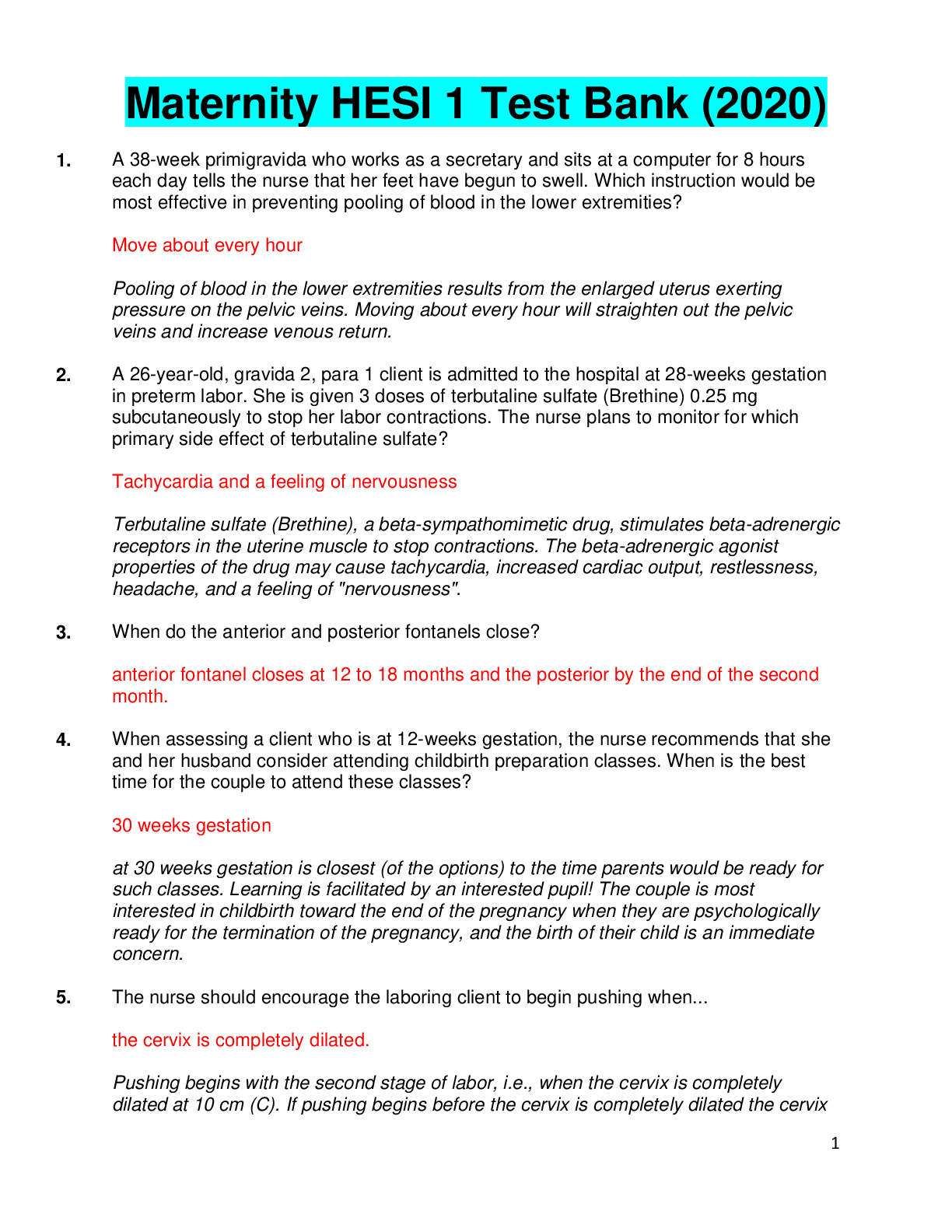

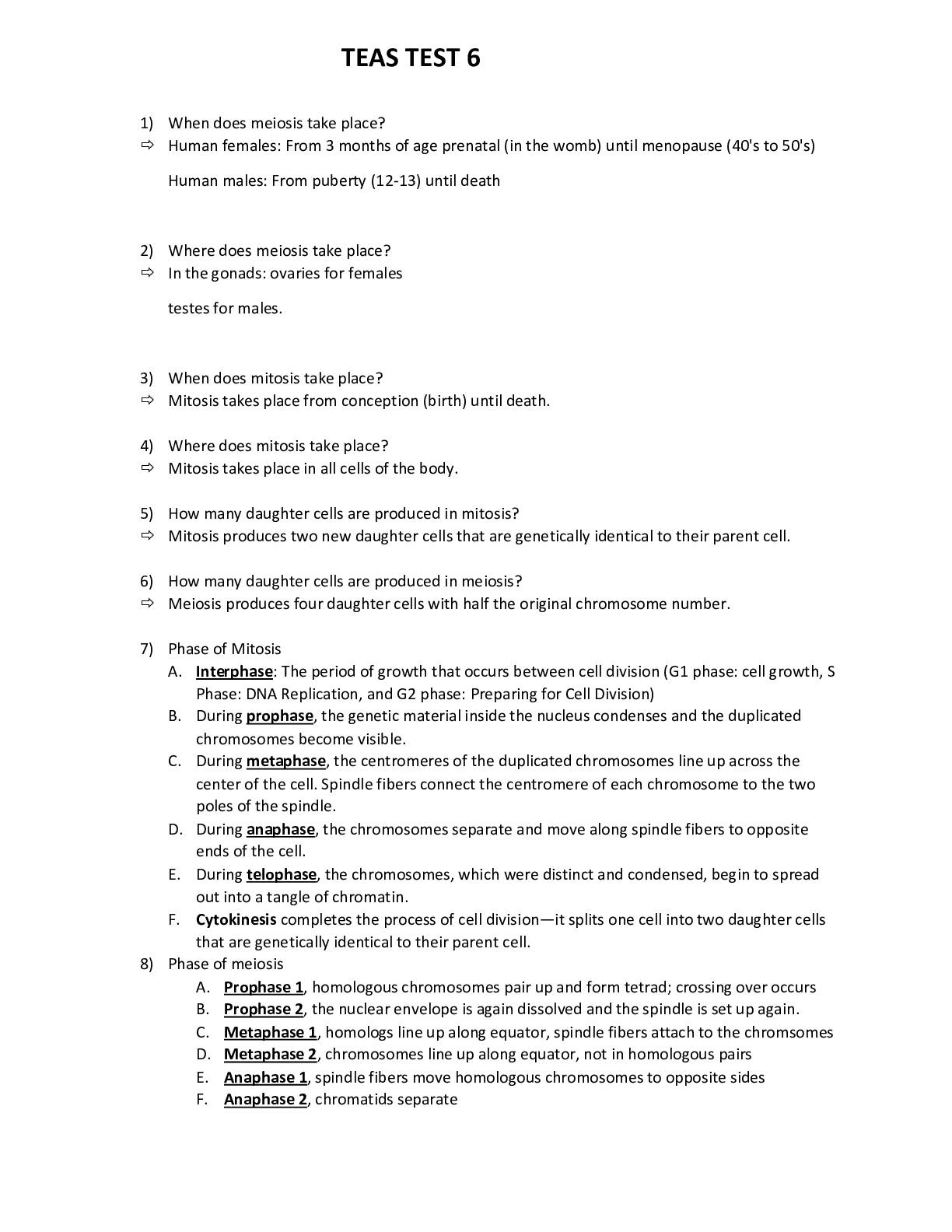
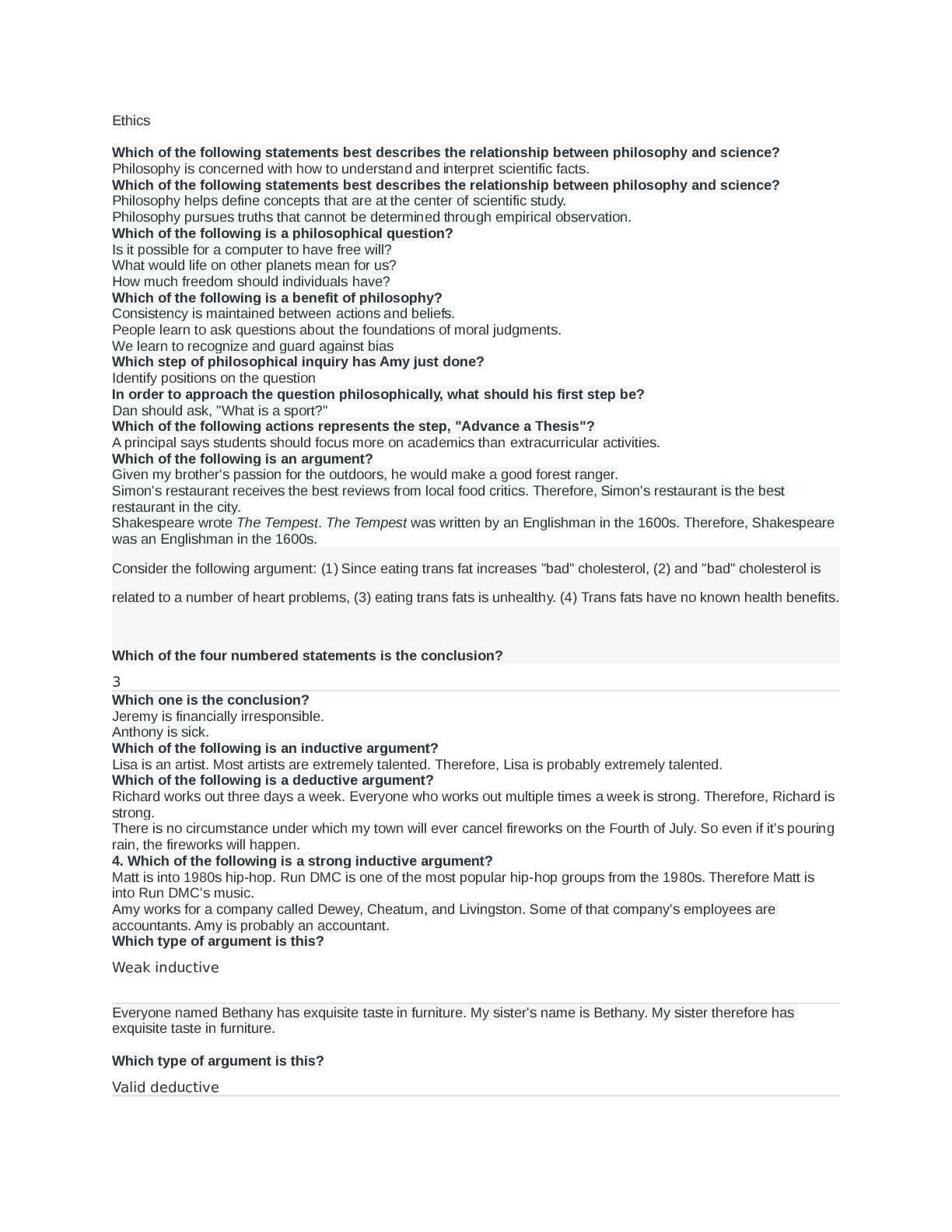


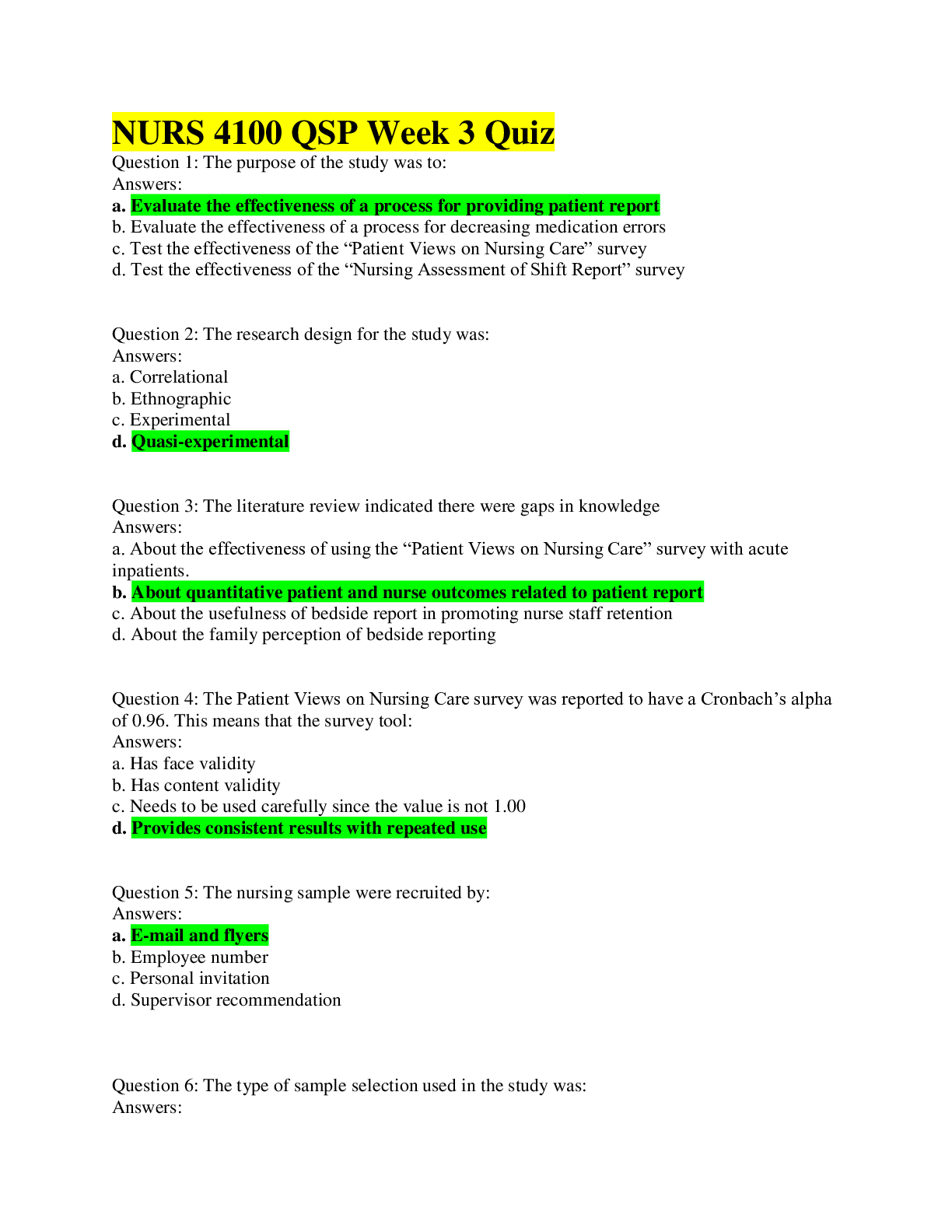
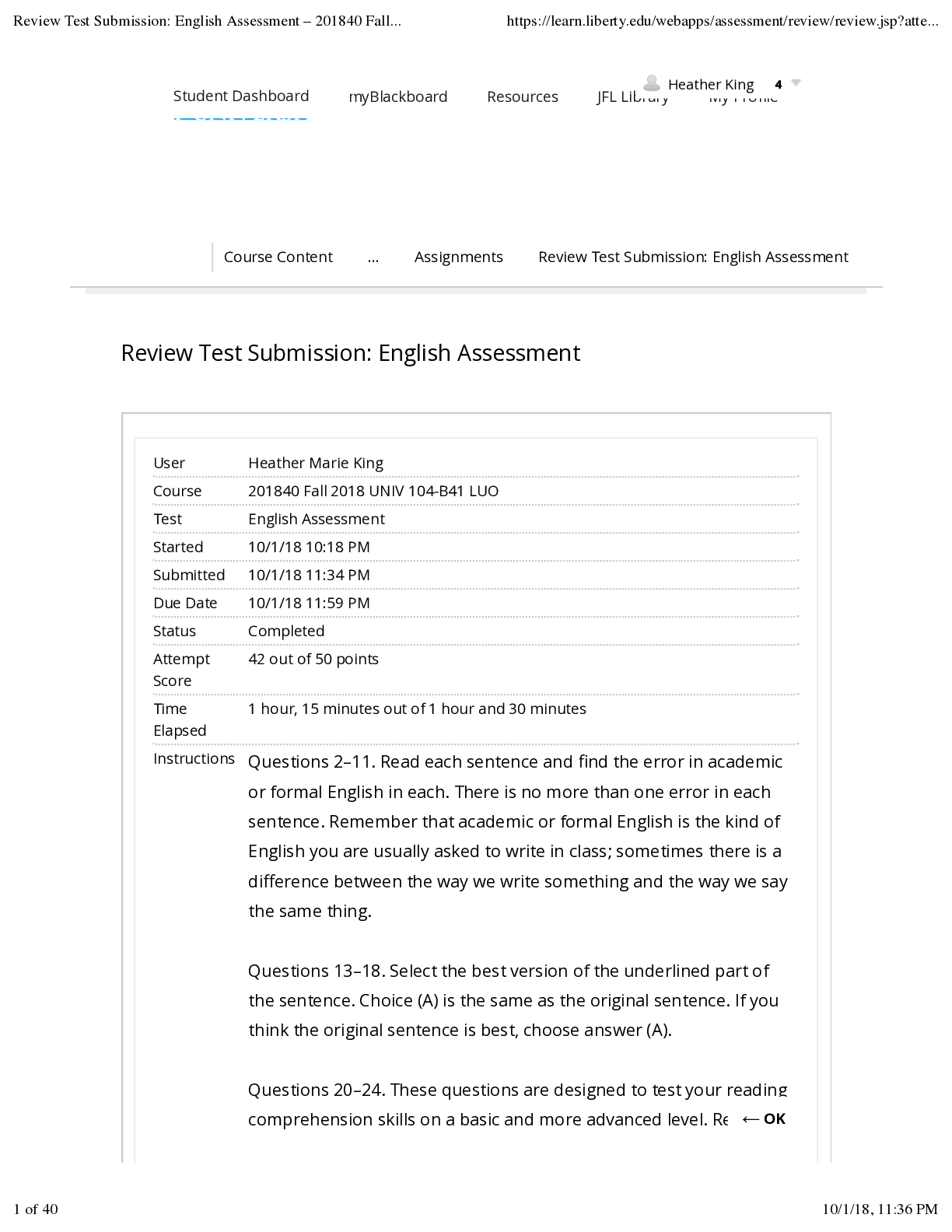
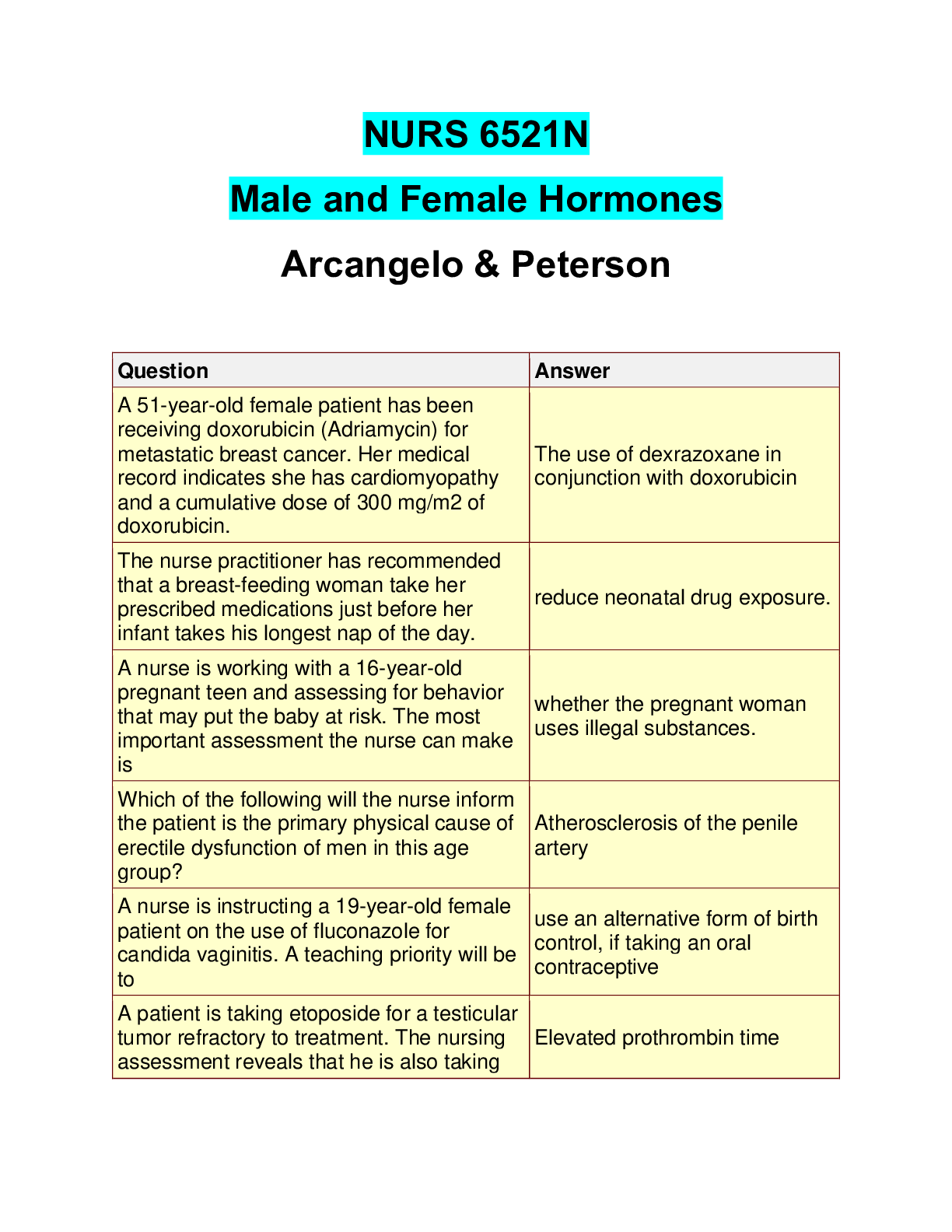

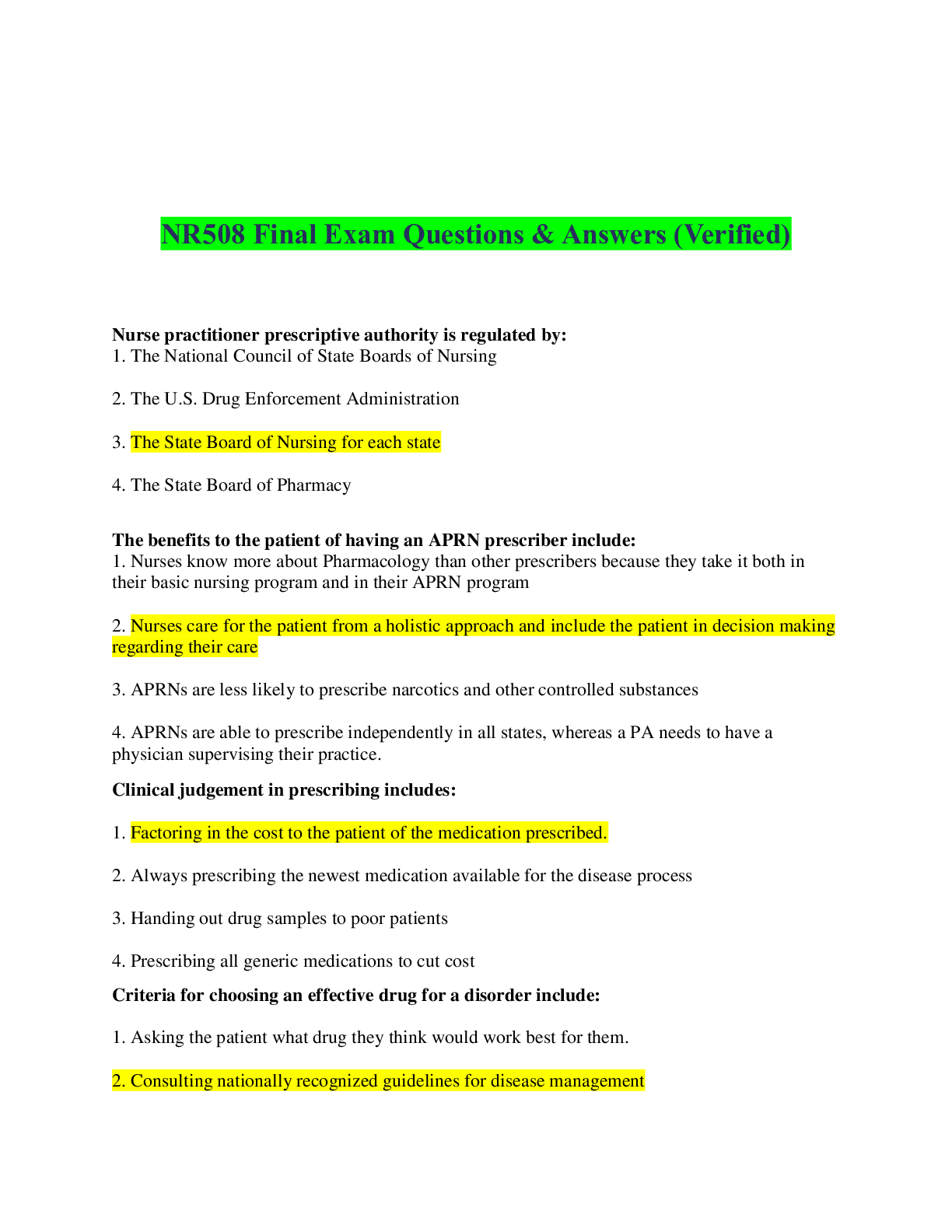

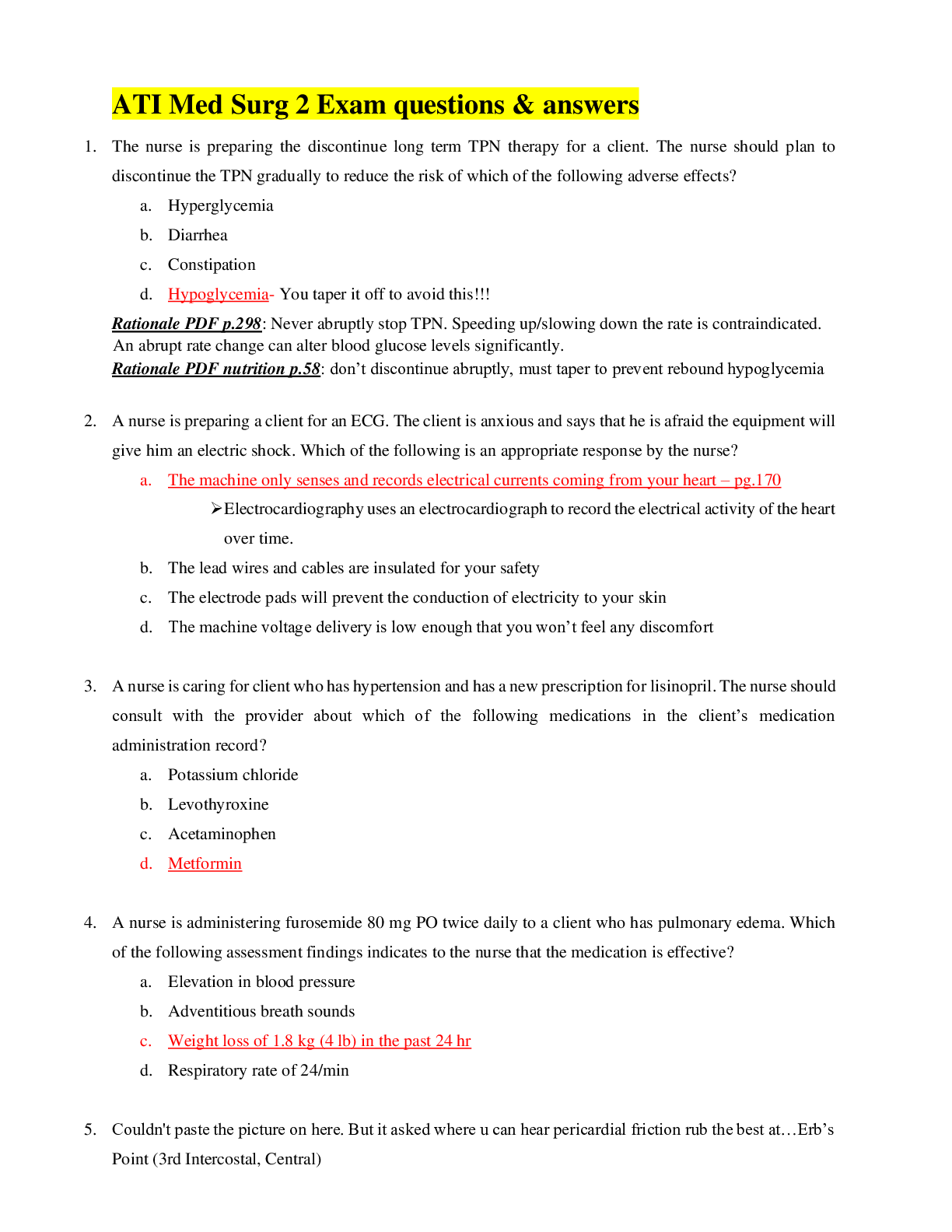


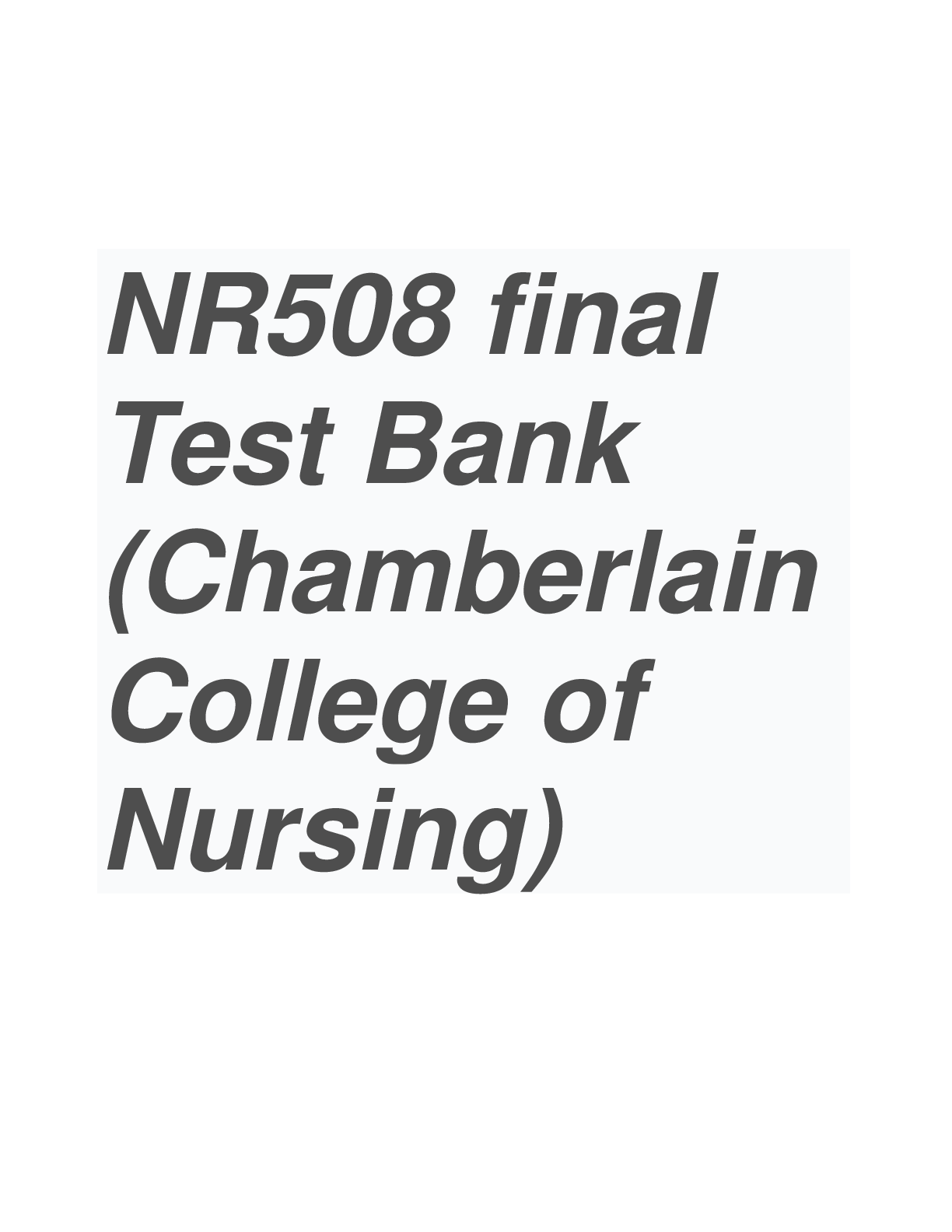

, 100% Correct, Download to Score A.png)

Download to Score A.png)

